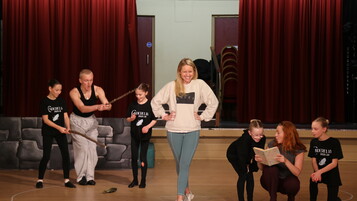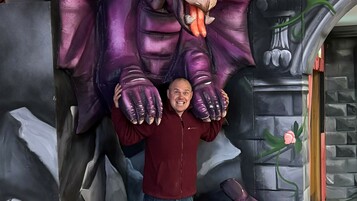News Story
Pantomime is a real celebration of the clownish, crazy and outrageous. They’re all about having fun and taking being theatrical to absurd and fantastic levels. Pantomimes are not pantomimes without a bit of gender role reversal and this primarily happens in the roles of principal boy and of course, the pantomime dame.
Below we’re going to look at the history of both roles, as well as taking a closer look at some of the most famous dames to grace the boards.
The Tradition of the Principal Boy
Despite what the name suggests, the principal boy is not traditionally played by a male actor. The principal boy has been played by a young female actor since women were first permitted to perform on stage. The romantic hero at the heart of pantomime is almost always played by a young female performer, dressed in a short tunic. It isn’t as popular as it once was but when pantomime was at its height in the Edwardian and Victorian eras, no panto was complete without the principal boy.
The fashion for female performers to take on this male role became established in the 18th century. The roles were described as “Breeches Roles” or “Breeches Parts” and they didn’t just apply to pantomime. Peg Woffington, a renowned performer of this age, was particularly known for her male role performances and bringing the idea of a female lead to the world of opera, such as Cherubino in the Marriage of Figaro.
The first principal boy in a pantomime appeared in 1819. Eliza Povey took on the role of ‘Jack’ at Drury Lane. By the late 19th century a female in the role of principal boy was all but cemented and an expectation of audiences arriving at a pantomime show.
Risque Characters and Audacious Ankles
In the Edwardian and Victorian times it was unheard of to see even the ankles of an attractive woman. Modesty meant even the legs of pianos were covered and you would never see a female performer with her legs out. Unless, they were in the role of principal boy or another “Breeches Part”. Actors playing male characters could take risks and bare as much leg as they dared, adding a further attraction to the pantomime and fuelling its popularity. Phrases such as “best legs in the business” became commonplace when discussing pantomimes and deciding which one to see.
Famous actors at the heart of the principal boy boom included Florrie Forde, Clarice Mayne and Dorothy Ward. By the early 20th century other big names included Adele Dixon, Evelyn Laye and Pat Kirkwood.
Many principal boys in more modern times are actors we’ve come to know on the stage, or pop musicians. Cilla Black spearheaded the return of the principal boy when she played Aladdin in 1971 and further names you might recognise from the principal boy roster include Su Pollard, Rula Lenska, Bonnie Langford and Loraine Chase.
On the opposite end of the spectrum to the principal boy, is of course the much-loved, heart and soul of the panto, the dame.

The History of the Panto Dame
The pantomime dame is a cornerstone of a successful pantomime. British theatre culture is nothing without the dame, but where did the idea even come from? Originally, no women appeared in theatre, so men had to play all the roles regardless of a character’s gender. Women began taking roles on the stage in the late 17th century, yet the clownish and flamboyant character of the pantomime dame still became an essential part of any successful pantomime.
A pantomime dame is simply a male actor dressed up to look like and play a female character. Makeup, special effects and costume are used to accentuate and ridicule female characteristics, giving the dame an exaggerated and hilarious paradoxical female appearance. The most famous dames have been known to wear huge prosthetic breasts, towering wigs and bold, bright colours. This costume is always matched with the fantastic acting skill of the dame, whose responsibility it is to be as over the top, melodramatic and theatrical as possible. Dames are usually a warm and supportive matron type character or wicked and demonic, the main antagonist in the show. Let’s look at some of the great dames of our time:
Les Dawson
Famous and beloved TV comedian Les Dawson also knew the role of the dame pretty well. He began pantomime in the late 1960s and regularly took on further roles as the dame in pantomimes throughout his career.
Roy Hudd
Roy Hudd was always a big name in the world of pantomime, but after years in a traditional male role he made the switch to skirts in 2015. He played a dame for the first time that year and hasn’t looked back. His dame debut was in Dick Whittington at Wilton’s Music Hall.
Berwick Kaler
Berwick Kaler holds the record for longest time serving as a pantomime dame. He is the longest-running consecutive panto dame and is a true institution at the York Theatre Royal. Even recent heart surgery did not stop him getting back on stage. His commitment to his art is fantastic and the chance to see him in panto should not be missed.
Clive Rowe
A beloved face on the Hackney pantomime scene, Clive Rowe has been recognised for the quality of his dame performance with an Olivier Award nomination. Last year he took on Jack’s Mother in the Hackney Empire’s Jack and the Beanstalk, and his commitment to his characters makes him a fantastic dame to watch.
Christopher Biggins
Biggins has claimed to be hanging up his skirts several times during his career as a mesmerising panto dame, yet he always comes back for more. He’s spent over 40 years starring in countless pantomimes and playing both wicked and wonderful dames for audiences across the UK. In 2022, audiences in Darlington as Mrs Smee in The Pantomime Adventures of Peter Pan.
Gender role reversal is a central characteristic of a great pantomime and these two roles epitomise just how fantastic a bit of a switch can be. While modern shows don’t always include a female in the role of the principal boy, the tradition of the pantomime dame is here to stay.
If this has whetted your appetite for seeing a pantomime this year, why not book your ticketsto watch Beauty and the Beast at Bournemouth Pavilion.



